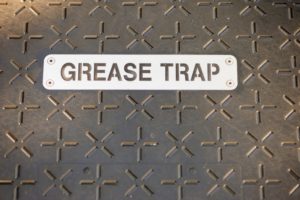
Fat, oil, and grease (FOG) are a sewer line’s worst enemies.
When poured down the drain, FOG coats the inside of the sewer pipe, eventually causing blockages and backups. Fortunately, your restaurant, hotel, or other business can prevent messy overflows by installing and maintaining grease traps.
What are Grease Traps?
Grease traps are also called grease recovery devices, grease interceptors, and oil management systems. No matter what you call them, grease traps are plumbing devices that intercept grease and oily solids before they flow into the wastewater disposal system. Without them, grease buildup would be a huge headache for business owners and the municipal sewer system.
Grease traps vary in size, from small floor traps to large tanks on the exterior of the building. They work by halting the flow of hot, greasy water, allowing it to cool. As this happens, the FOG separates from the water and floats to the top. There, the trap collects the grease so the wastewater can flow down the drain without causing clogs.
What Businesses Must Install Grease Traps?
Restaurants and other businesses that process, prepare, or serve food must present the city with a FOG management plan. This plan may include installing grease traps and performing regularly scheduled maintenance. Depending on the amount of grease your operations produce, you may even need a FOG Permit. Don’t skip these regulatory steps, or you could face significant fines and penalties.
Grease Trap Cleaning & Maintenance
Be aware that localized FOG buildup often occurs between the commercial kitchen drain and the grease trap. These pipes should be hydro-jetted regularly to avoid clogs. As for maintaining the grease trap itself, follow these tips:
- Consider installing an enzyme drip system: Just as healthy bacteria help with proper digestion, an enzyme drip system can improve the health of your drain lines. This addition to your grease recovery device can help further dissipate grease before wastewater enters the municipal sewer system.
- Pump the grease trap and tank: As oily water flows down the drain, your grease tank gradually fills with FOG. Depending on your usage and the size of your trap, you may need to have it pumped as often as every few months.
- Clean and maintain the grease trap and tank: Keep your inlet and outlet lines, tank walls, and baffles as clean as possible with routine maintenance. Regular cleaning ensures optimal performance, prevents foul odors in your kitchen, and keeps fire hazards at bay.
- Regularly dispose of and recycle grease: Once you’ve emptied and cleaned the grease trap, the final step is to dispose of the FOG properly. Be sure to document your responsible disposal and recycling efforts for compliance purposes.
Trinity Liquid Waste is a family-owned company proudly providing grease trap pumping and maintenance services to Pleasanton, CA businesses. Our professional technicians are committed to providing top-notch services to keep your business sanitary, compliant, and affordable to operate. If it’s time for your next visit, please contact us online or call 510-874-6489.
““
